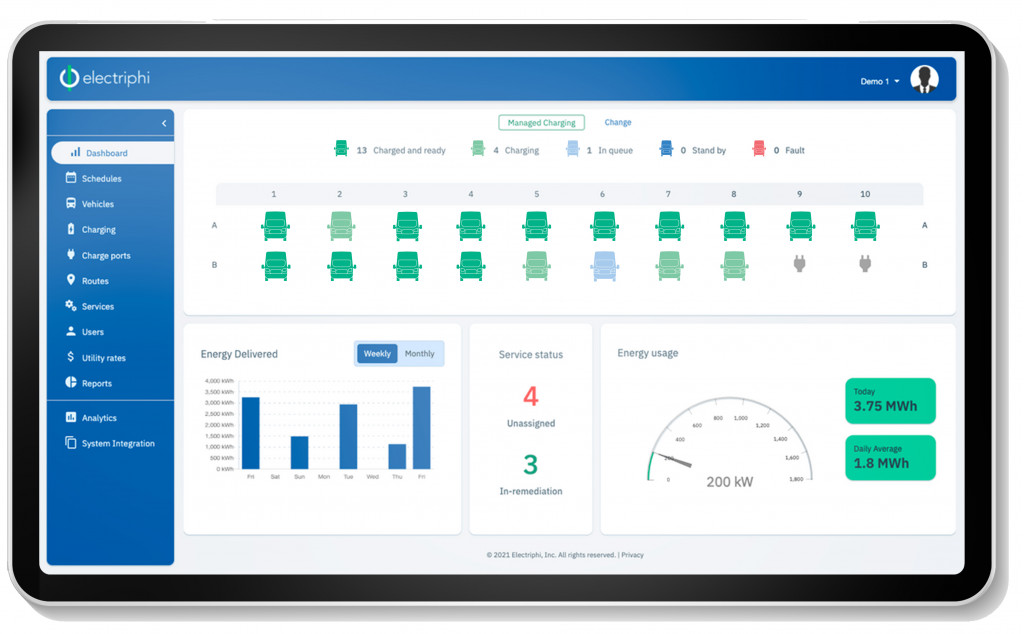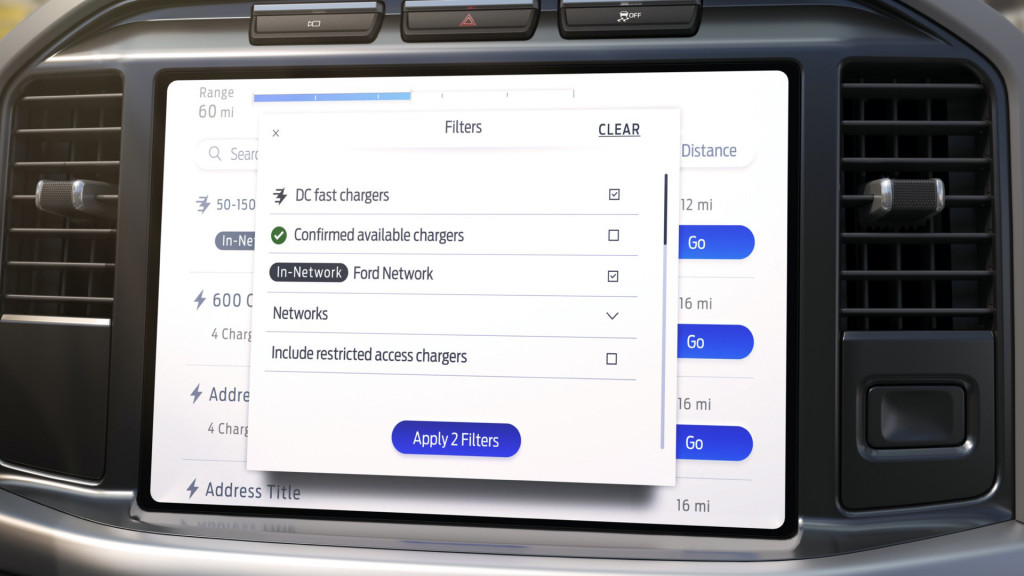Ford earlier this month made an investment that will help connect the dots in selling the F-150 Lightning Pro and E-Transit electric trucks to fleet managers at companies big and small.
The acquired company is called Electriphi, and it took just a short check-in with CEO Muffi Ghadiali, to understand how important it is in this transition.
Electriphi is one of a handful of contenders—including Amply and Greenlots—aiming to help inform EV fleet management and make sure that businesses charge their fleets in a way that minimizes the cost of electricity and, perhaps, helps them meet renewable energy targets. To do that, it uses math and complex modeling and does some hand-holding between companies and utilities to help finesse supply and demand.

2022 Ford F-150 Lightning Pro
Meanwhile, Ford is aiming to do more than sell work-oriented EVs. Through Ford Pro, it intends to make money from fleet management and such charging guidance, with a goal "to capture over $1 billion of revenue from charging by 2030." It also sees the "depot charging industry" growing to more than 600,000 full-size trucks and vans by 2030.
Ford plans to integrate Electriphi’s software within its Ford Pro telematics solutions, and it should help answer a big source of unease in the EV transition: predictability. Fleet managers anticipate and amortize, and map out the running costs of the vehicles a business needs. And while the ownership-cost benefits of electric vehicles are an easy sell, deciding how to charge, when to charge, and understanding how much it costs is not.
It doesn’t work like gas and diesel
Fleet managers have been contending with volatile gas and diesel prices for decades, and they know how to deal with it and smooth the peaks and troughs. If the fleet gets large enough, they can vertically integrate their fuel, create their own fueling depots, and enjoy economies of scale on fuel.
But now it’s electrons moving along wires. There are no economies of scale on electricity, or vertical integration, and outside of costly storage arrays the best answer is simply to be mindful of supply and demand.
That’s a challenge in itself. The U.S. grid isn’t so much a national grid as a mishmash of 3,300 different local or regional utilities that represent some very differing ideas about embracing renewable energy and billing for use.

2022 Ford F-150 Lightning
Most utilities are accustomed to predictable generation, distribution and consumption, but they see a catalyst in this new load coming onto the grid for vehicle charging, Ghadiali says. “Most importantly, they want to figure out how they can control this as well, because with electrons they’re generated because there’s demand, right, unless you have storage at the edges.”
While Electriphi produces fleet tools, it also helps utilities gain access to fleet information, so they can potentially understand how to predict demand and also to some degree control it. So it amounts to a valuable advisor in the middle, informing fleet operators when they should charge to meet the utility’s output and best prices, and when and where, on a larger scale, big corporate fleets with a greater number of electric vehicles will be arriving and plugging into the grid daily.
Navigating supply and demand
The tech firm stands at the intersection of fleets and utilities and hopes to add value for both. “Electriphi aims to help fleets make sure their vehicles are charged and ready when needed, while minimizing the energy cost as much as possible,” Ghadiali said. “And on the utility side it aims to provide predictions of what this load is going to be.”

Ford Pro - Electrifi dashboard for EV fleets
Electriphi’s software helps look at every single vehicle, the people and schedule, and how much energy is needed in each vehicle every day. All that feeds into a sorting algorithm including utility rates, and it helps decide when to start charging a given vehicle and how quickly to do it.
Electriphi has developed two solutions, with differing levels of hands-on control. If the infrastructure already has the software the product is “really very dynamic,” Ghadiali said. Separately it offers some sophisticated load modeling, in which fleet managers input what kinds of vehicles they have, how they plan to operate them, and when they hope to charge.
Even based on the latter, Electriphi can look at the time-of-use rates that a business is paying at different locations and determine when, where, and even at what rate to charge each vehicle. The solution will be part of Ford Pro telematics services in helping to understand each fleet’s duty cycle, idiosyncrasies between vehicles and drivers, and how they operate.

2022 Ford F-150 Lightning Pro
At the heart, Electrifi is a data company. The software will also help fleet operators and finance managers verify that the promises of electrification are holding true, and it will provide monthly reports on how much energy was used and how much money was spent.
Ghadiali also said that it’s easier for companies to get carbon credits and low carbon fuels credits (California, Oregon, and Washington) because businesses have it all documented. They know exactly how much electricity was used by each vehicle, under what rate, and how much diesel or gasoline was displaced.
Becoming a marketplace?
The decisions about charging and energy use that fleets now make are based more on historical patterns rather than any sort of real-time handshake, but the future looks more like a series of negotiations within marketplaces. “You’re creating dynamic marketplaces where you can incentivize customers to shift load,” Ghadiali anticipated about the future.
That’s a necessary future. The existing grid will have to nearly triple in order to provide the charging resources (by BTU) to replace internal combustion with all-electric over the next several decades. As renewable energy gets brought on and demand changes from vehicle charging, it’s even more important.

2022 Ford F-150 Lightning
“The electrification of transportation is a massive forcing function that will redefine energy markets and utility grid operations,” said Mike Ulczynski, the director of Ford Pro Charging. “Renewable energy coupled with decentralized energy resources will play a key role in the transformation.”
Ulczynski didn’t have numbers to share about how the market for renewable energy might change with a more coordinated approach for fleets. “These are incredibly complex ecosystems and it only gets more indeterminate as we layer on the disruption across these segments,” he said.
Just a small portion of U.S. utilities are thus far engaged in the dynamic aspect of Electriphi’s work. With some of the less tech-savvy utilities, it will simply work from the utility’s billing of a company backwards, looking at time-of-use rates and model a fleet’s needs around that.
The future
Concepts that vertically integrate electricity across charging depots or lets vehicles in fleets “roam” across utilities might be part of the future, but they’re a decade or more away.
In the meantime, Ghadiali said that there’s potential in seeing if a company can reimburse its drivers to charge at home sometimes or regularly—perhaps saving money in the process—as part of a model to keep costs to a minimum and green energy to a maximum.

2022 Ford F-150 Lightning Pro
Furthermore there’s future potential in expanding Ford’s Pro tech to functionality that some F-150 Lightning buyers will appreciate—like mapping out charging times, the use of home solar, and the use of their trucks as an energy management device.
“We anticipate that vehicle charging and energy management will need to seamlessly blend between professional and personal activities,” said Ulczynski.
Just as IT departments have felt the strain of the shift to work-from-home this past year, some fleets will likely have to confront a similar shift in the role of electric fleet vehicles—with tech helping make an informed choice.












